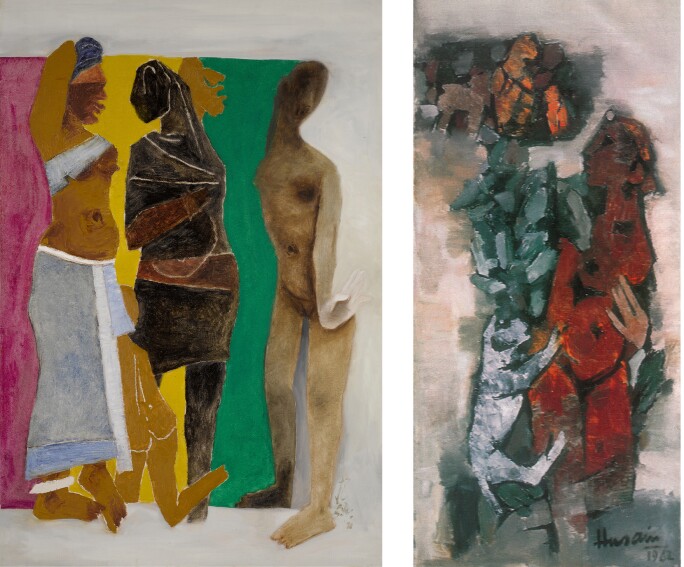Maqbool Fida Husain was a maverick and a legend, observing the extraordinary and ordinary all over India and the world. He walked barefoot, did not carry money in his pocket, and remained a wanderer all his life.
As he interpreted Indian art, Husain also defined it. His strong brush strokes, bold use of colour, Cubist-like aesthetic and recurring motifs such as horses and women are integral to India’s visual memory. The 1960s were a stirring period for Husain’s ideology and style. The disastrous Sino-Indian War in 1962 and the Second Kashmir War in 1965 contributed to a certain pessimism that inspired Husain to experiment with fame and the act of painting. In 1967, he completed his Kerala series, a body of work that explored the Brahmins of the region and their rigid caste views. 'He made twenty-two works that he exhibited at the Pundole Art Gallery in Bombay. But instead of signing the works, he had them labelled as paintings by a ‘talented young man.’ The paintings were priced at Rs 400 each. None of the works sold… Husain allowed sufficient time to pass before signing the works in his distinctive style and mounting the exhibition, now under his name. Within moments of the opening, most works had sold at twice their original value.' (K. Singh, M F Husain: The Journey of a Legend, Stellar International Art Foundation, New Delhi, 2014, p. 46)
In 1968, Husain had not prepared sufficient paintings for an exhibition at Shridharani Gallery. So, at the suggestion of art critic Richard Bartholomew, he hung blank canvases and 'painted for two or three hours each evening for six days. The Shridharani Gallery, naturally, was packed.' (K. Singh, M F Husain: The Journey of a Legend, Stellar International Art Foundation, New Delhi, 2014, p. 48) Indeed, Husain mocked his own celebrity and the real value of his art with creative stunts. These moments reveal a point of maturity in Husain’s career that proves his art transcended materiality. It was no longer about what was on the canvas; it was about what it represented.
At the culmination of this period comes Naked Play Two, painted in 1970. Husain is about to embark on a decade defined by grandiosity and truly global success, beginning with a monumental portrayal of the Mahabharata at the Sao Paula Biennale in 1971. But, before he began his study of epic heroes, Husain elaborated on his portrayal of women.
'The central concern of Husain’s art, and its dominant motif, is woman, and it is this motif that now best embodies these two moods [inner quest and spiritual anguish]. Man, in Husain’s view, is dynamic only in heroism. He is diminished by confusion and broken by unbelief, and these are unheroic and unbelieving times. Spiritually, woman is more enduring. Pain comes naturally to her, as do compassion and a sense of the birth and death of things. In Husain’s work, woman has the gift of eagerness […] and an inward attentiveness, as if she were listening to the life coursing within her.'

RIGHT: M.F. Husain. Naked Play, 1962
Reproduced from R. Bartholomew and S. Kapur, Husain, H. N. Abrams, NY, 1972, illustrated plate no. 75
Perhaps unsurprisingly, Husain engaged with this theme eight years prior with the first Naked Play in 1962. In this work, Husain developed his motif of the woman, her form and her relationship to other subjects. A monkey climbs her right side while a hand seems to caress her left hip from behind, and a bull-shaped figure emerges over her shoulder. Naked Play Two removes animals from the conversation and instead focuses on three women and their relationship to one another, and, in turn, with the viewer. The woman on the right is shown in striking side profile, her arm bent beside her head. A child, whose two dimensional form is infilled in the same rich ochre colour, hides behind her skirt. The woman in the centre is rendered in dark black and brown tones, her right arm extending across her body to hold her sari to her chest. Her blank visage is flanked by another face in profile behind, an anonymous figure or perhaps a reflection of multiple sides of the woman's psyche. On the far right, distinct from the other figures, is a enigmatic nude. Her stylized hand gesture is complemented by the soft tribhanga position of her body. All three women are pictured in unique corporeal and tender ways.
Despite the nudity of the women, Husain exposes something deeper about their spirit in their faceless and sometimes featureless bodies. Husain does not sexualize these women, but rather their bodies represent ideas far greater than the female figure itself. The sombre, earthy tones of their forms are deftly contrasted with the vibrant colour fields of pink, yellow and green behind.
Naked Play Two is a masterpiece that proves both Husain's command of his craft and his self-assuredness as an artist and interpreter of the human experience.

